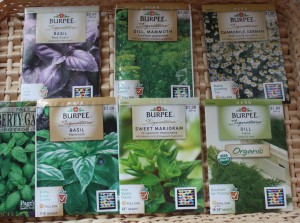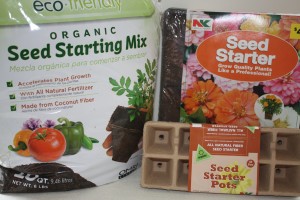Some perennial herbs can be started from seed. Mints on the other hand usually should be grown from transplants because you don’t know what mint you get from seeds. Listed below is a partial list of perennials that can be grow from seed:
- Chamomile, Roman (Note: German Chamomile is an annual)
- Horehound
- Winter Savory
- Garden sage
- Common thyme
- Hyssop
- Lemon balm
- Pennyroyal
- Wormwood
- Greek Oregano
- Chives
- Lavender
- Lovage
- Rue
- Fennel
- Echnicea
Annual Herbs that can be started from seed
- Calendula
- Borage
- Basil
- Dill
- German Chamomile
- Clary sage
- Coriander/Cilantro
- Marjoram
- Summer savory
- Anise
- Chervil
- Parsley (bi-annual)
Starting your herbs from seeds is much cheaper than purchasing the plant and sometimes the variety is better. It is not always easy to fine several kinds of basil, but several variety can usually be found in seeds. There are some wonderful seed saving companies and organic seed companies you can find if you search the web.
Herbs such as variegated thyme, purple and golden sage, French tarragon are usually not grown from seeds, these are best grown from cuttings or plants.
Four things are needed to start seeds:
- Moisture
- Air/Soil
- Light
- Temperature
Moisture: All seeds need moisture to germinate, and if the soil dries out before germination the seeds will die.
Air/Soil: An organic, peat base soil-less mix made for seed starting is what I like to start with. Seeds need air to grow roots, and the wrong kind of soil will prevent this.
Light: Seeds for the most part need light, especially after they have germinated, don’t plant them to deep. This is one mistake many new to seed starting make, they plant tiny seeds deep in their seed starting pot. Tiny seed should be planted near or on top of the soil. Always check the package, it usually has a ton of information.
Temperature: Most seeds need a warm climate to germinate. I like to place my trays with seeds on top of my refrigerator or on top of crate over a grate. These are warm places and I’ve had pretty good luck with this method. Some seeds growers will buy heat mats just for this purpose and they work as well, just cost more.
Gather your materials, at this time of year go into any garden center and you will find all kinds of seed starting materials. I like to use trays with plastic covers for most annuals and peat pods for herbs such as parsley which really doesn’t like transplanting.
Place the peat pod trays in a plastic tray and fill with seed starting mix. Moisten well and allow the soil to absorb the water. Plant the seeds in each pod two or three seeds per pod. Cover with plastic wrap and place on top of the frig or anywhere it is warm. Check often and as soon as you see growth, get the plants in light.
Some trays already have soil, just moisten them well before planting seeds. They usually have a plastic cover you place over the seeds until germination. Once you see some green, take off the plastic cover and place it under light.
Place a grow light about 2″ above the top of the plant and as it grows, move the grow light to stay in the 2″ range. The grow light should be on about 12- 14 hours. I like to put in on a timer so it will come on and off automatically. I use an old baker rack where I can chain a light to the underneath of each shelf and change the height of the light as the plants grow. I use a shop light with a cold and warm bulb.
Keep the plants under the grow light until it needs to be transplanted and set outside in a protected area to harden off.
To Harden off: Set the plants under an old window frame on top of bricks or bales of hay. Watch the temperature, it it gets too hot, it will cook the plants. When the sun comes out or if the temperature increases remove the window frame. After a week or two or when the temperature warms, set out perennials. Most annuals need to be set out after frost date, check your seed package.
Basil does not like anything below 40 degrees F. Annuals seeds need about 6 weeks to grow to a size for taking outside. Perennials may need much longer. Echnicea takes forever to get any size.
Some herbs can be planted directly in the garden such as Cilantro and Parsley. Even if you don’t have the area for starting them indoors plant the seeds outside, it may take a while but they usually grow.
Another way is to ask your friends or join an herb club. Most herb lovers will share their plants. In many cases we need to share because herbs can grow in abundance.
Happy Gardening


